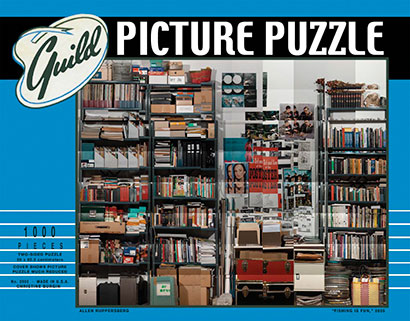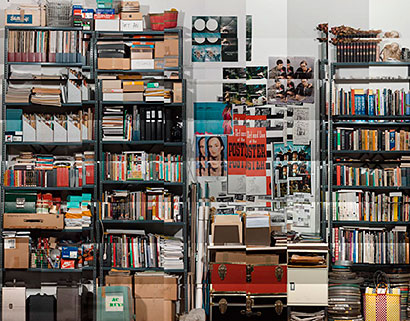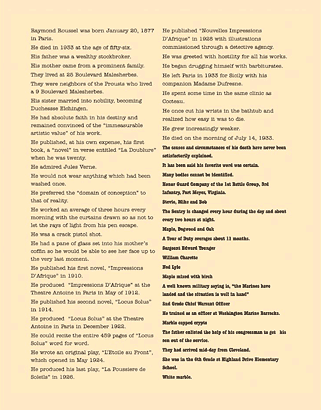
Allen Ruppersberg
Lines, Drawings, Book Pages, Games and a Puzzle
January 7 - February 19, 2005
"In isolation, a puzzle piece means nothing -- just an impossible question, an opaque challenge. But as soon as you have succeeded, after minutes of trial and error, or after a prodigious half-second flash of inspiration, in fitting it into one of its neighbours, the piece disappears, ceases to exist as a piece. The intense difficulty preceding this link-up -- which the English word puzzle indicates so well -- not only loses its raison d'etre, it seems never to have had any reason, so obvious does the solution appear. The two pieces so miraculously conjoined are henceforth one, which in its turn will be a source of error, hesitation, dismay, and expectation."
- Georges Perec, Life a User's Manual
In the preamble to his 1978 novel Life a User's Manual, Georges Perec attempts to explain the strange nature of jigsaw puzzles, an enterprise of profoundly perfect yet simultaneously futile solutions. He does so by way of introducing Percival Bartlebooth, the main character of the story to follow, an artist who devotes his life to the elaborate creation and destruction of jigsaw puzzles of his own making. Perec's musing on this subject might also help to ellulidate the work of Allen Ruppersberg. Since the early 70s, Ruppersberg been making artworks that in many ways function as puzzles: a collection of elements arranged to make up a meaningful whole. In a recent series entitled Honey I Rearranged the Collection, for example, Ruppersberg rearranges elements of his own works from the 70s into new configurations. He accompanies these new works with imagined quotes from a fictional "collector" who explains the reasoning behind such a new arrangement of the "collection." Ruppersberg's own collection has been a primary source of material for his artwork. It is a vast and ever-expanding collection, a wide-ranging archive of material including pulp fiction, comic books, vanity press publications, industrial and educational films, posters and an assortment of ephemera and objects of a certain nostalgia including the original Fishing is Fun a puzzle from the 50s on which this puzzle and its box are based. One wall of Ruppersberg's collection, as it was installed in his former New York studio, is pictured on the cover of the Fishing is Fun puzzle box and on one side of the puzzle. On the other side of the puzzle are a series of brief observations -- a puzzle in text -- describing two individuals who have influenced Ruppersberg as an artist: Raymond Roussel, and the Unknown Soldier.
In choosing to make a puzzle, Ruppersberg allows the viewer, the puzzler, to take on his role as an artist. Like the artist, the puzzler must fish about amongst the pieces of Ruppersberg's studio in order to construct a work, assembling hidden influences on the reverse while doing so. But, as Perec understands and describes so well, the role of the puzzle-maker is complicated. "Despite appearances, puzzling is not a solitary game: every move the puzzler makes, the puzzle-maker has made before; every piece the puzzler picks up, and picks up again, and studies and strokes, every combination he tries and tries a second time, every blunder and every insight, each hope and each discouragement have all been designed, calculated and decided by the other." Puzzler or puzzle-maker? It is Ruppersberg's particular genius as an artist to be both.
Allen Ruppersberg
Lines, Drawings, Book Pages, Games and a Puzzle, 2005
Installation view, Christine Burgin Gallery, New York
puzzle box
puzzle front
puzzle back
"Fishing is Fun," 2005
1000 piece two-sided hand-cut wooden jigsaw puzzle in box
Finished puzzle: 19 1/2 x 24 1/2 inches
Box: 11 x 13 x 2 inches
Edition of 15